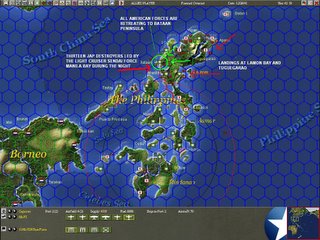ACTION SUMMARY: Aside from continued fighting at Yenen and Wuchow, the only major event today was a Japanese landing at Tarawa Atoll in the Gilbert Islands. Situation some 120 miles from the Japanese bases in the Marshall Islands, the atoll (if built up with airfield installations) could pose a serious threat to my lifeline to Australia. Despite the fact that the Enterprise was operating off the Marshalls just a week ago, launching a strike against Maleolap, the Imperial General Staff still went ahead with these landings. It leads me to believe that he backed these landings up with sufficient forces to cover them from my marauding carrier task forces. Could he have concentrated at least some of his carriers in this area? I do not know.
My subs have been operating off the Marshalls along the convoy sea lanes to the west leading back to the Japanese home islands. They have reported no activity except for the Narwal scoring a torpedo hit on a Jap transport operating off Kwajeilin. Because my lifeline to Australia is so important, I continue to improvise the shifting of forces to the Congo Theatre. This is especially so now since this is the first Jap offensive activity I've seen in that theatre since December 7th, and now there is reason to believe he is putting some force behind it. As it were, I need more eyes there, and more to the point, I need more air power there.
I deployed a squadron of 14 B-17's to Canton Island, part of a large a bombing group I've kept in Hawaii since the war began. The rest of the B-17's will follow when sufficient base personnel have arrived. Congo convoys are enroute to deliver them. These B-17's will be used to cover a less mundane operation on Baker Atoll, which could get exciting.
Baker Atoll. Used extensively in the nuclear tests during the 1950's, only an abandoned Pacific Clipper station is there for my Catalinas to operate from. The island is just 180 miles west of Tarawa. If I were the Imperial General Staff, I'd want to dislodge any Allied forces from Baker, which is 250 miles from the nearest Allied station in the South Pacific. I've cut my recon flights in half, and given them reach over the Marshalls to discern Japanese intentions in this critical piece of saltwater real estate. As it were, it is my intention to reinforce Baker with an engineering battalion now loading at Pearl. I've also ordered the Lexington to replenish at Palmyra Atoll at hold its position there. If trouble erupts off Midway or Wake Island (and it may if old intelligence still holds), she can sail for Pearl Harbor quickly. But she will stay off Palmyra as two more Congo convoys depart for Canton Island, including 30+ B-17's and 25+ Tomahawk fighters boxed up in the holds of my transports. There is also the convoy loading for Baker, and an additional engineer battalion also departing for Canton.

It is possible that my efforts to effect even a minimal presence on Baker Atoll could provoke a fierce enemy reaction. It will be at least another week or two to find out what he really will do, but I'm not taking chances. The Congo Theatre is being ratcheted up to a priority theatre over Bolo... especially since I need to keep up offensive operations to retain some initiative. If I reinforce Baker (particularly with bombers), then it really would be foolish for the enemy to continue through an operation against Wake or Midway... because I threaten the Marshalls while losing Wake or Midway will gain the enemy very little.
At any rate, the U.S.S. Yorktown will be coming coming out of drydock at San Diego in two weeks. I will have four powerful aircraft carriers available for operations in the South and Central Pacific. As for the other theatres, no special events except for the fighting at Wuchow and Yenen. The Chinese continue to resist pretty well in Yenen despite being heavily outnumbered. I suppose the only real special event was the fact that there was a notable lack of Japanese air activity over China today. This gave me great pleasure knowing that my opponent had to cancel every operational order for his bomber groups in China because he has seen in excess of 40+ of his bombers shot down at the hands of the Flying Tigers.
Here's the warroom, with an emphasis on Congo, and locations of the major Japanese bases throughout the theatre.




















































